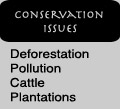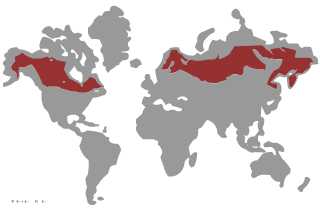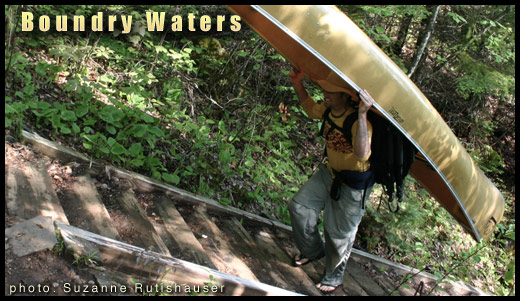


Boreal forests
In this episode you'll learn:
- Where boreal forests are found
- Boundary Waters Case Study
- What animals are found in the boreal forest?
- Forest Climate
- Growth form adaptations
 Introduction. The boreal forest (also known as the taiga, a russian word meaning swampy moist forest) is found in a nearly continuous belt across North America and Eurasia. Most of Canada and Russia are covered by coniferous trees that make up this biome. This biome is defined mainly by the trees that compose it. The climax trees are furs, spruces and pines. Subclimax plant communities may have deciduous trees like larch, tamarack and birch. Much of the zone that this biome covers was formerly glaciated. Today large sections have permenent permafrost.
Introduction. The boreal forest (also known as the taiga, a russian word meaning swampy moist forest) is found in a nearly continuous belt across North America and Eurasia. Most of Canada and Russia are covered by coniferous trees that make up this biome. This biome is defined mainly by the trees that compose it. The climax trees are furs, spruces and pines. Subclimax plant communities may have deciduous trees like larch, tamarack and birch. Much of the zone that this biome covers was formerly glaciated. Today large sections have permenent permafrost.
Climate: The boreal forest corresponds with regions of subarctic and cold continental climate. There are long, severe winters (up to six months with mean temperatures below freezing) and short summers (50 to 100 frost-free days), as is a wide range of temperatures between the lows of winter and highs of summer. For example, Northern Minnesota, near the boundry waters where we canoed, has recorded extremes of minus 70 ° Fand plus 100 ° F. Mean annual precipitation is 15 to 20 inches,(55 to 70 inches in the boundry waters) but low evaporation rates make this a humid climate.
 Vegetation: This biome has very characteric trees. Dominant trees in the tiaga are Needleleaf, coniferous (gymnosperm) trees. From a biodiversity standpoint, there is little diversity in the main trees. The four main genera found are: the evergreen spruce (Picea), fir (Abies), and pine (Pinus), and the deciduous larch or tamarack (Larix). In North America, one or two species of fir and one or two species of spruce are dominant. Across Scandanavia and western Russia the Scots pine is a common component of the taiga.
Vegetation: This biome has very characteric trees. Dominant trees in the tiaga are Needleleaf, coniferous (gymnosperm) trees. From a biodiversity standpoint, there is little diversity in the main trees. The four main genera found are: the evergreen spruce (Picea), fir (Abies), and pine (Pinus), and the deciduous larch or tamarack (Larix). In North America, one or two species of fir and one or two species of spruce are dominant. Across Scandanavia and western Russia the Scots pine is a common component of the taiga.
There are several other trees that can be found in this zone. They are early succesional trees (trees found in disturbed habitats that over time will be replaced by the climax community of spruce, firs and pines). The most common trees are the deciduous alder (Alnus), birch (Betula), and aspen (Populus).
Growthform Adaptations: The main reasons firs, sprucs and pines are the dominant trees in the boreal forest, and thus define the biome is because they are adapted to the extreme conditions brough about by the cold, including the winter-induced drought and the short growing season. The following are some of the main adaptations we found that trees in this zone have:
- Conical shape - promotes shedding of snow and prevents loss of branches.
- Needleleafs - narrow leaves reduce surface area through which water can be lost (transpired), especially in the winter when the frozen ground prevents plants from replenishing their water supply. The needles of boreal conifers also have thick waxy coatings--a waterproof cuticle--in which stomata are sunken and protected from drying winds.
- Evergreen habit - retention of foliage allows plants to photosynthesize as soon as temperatures permit in spring, rather than having to waste time in the short growing season merely growing leaves. [Note: Deciduous larch are dominant in areas underlain by nearly continuous permafrost and having a climate even too dry and cold for the waxy needles of spruce and fir.]
- Dark color - the dark green of spruce and fir needles helps the foliage absorb maximum heat from the sun and begin photosynthesis as early as possible.
Soil: Podzolization occurs as a result of the acid soil solution produced under needleleaf trees. The main soil order associated with the taiga is spodosol.
Other explanations of boreal forest
- Center for Education Technology about Biomes
- Blue Planet Biomes (Taiga)
- Living Biomes (Taiga)
- Neartica.com (Taiga)
Boundary Waters Case Study, Northern Minnesota
In May of 2006, Suzanne and I decided to take a trip to the Boundary Waters Canoe Wilderness in Northern Minnesota in an effort to discover what boreal forests were all about. If you look at any map of boreal forest you'll notice that the lower extension of this biome dips into Northern Minnesota. We were prepared for the canoe trip, but we were very curious about the biome.

Everywhere we went we read about boreal forests. It said they were in the area, but we still didn't know what it was. As it turns out boreat forests are determined mostly by the trees in the area. Certain parts of the forest were more 'typical' boreal forest than others. Those with more red pine, white pine, spruce and fir, and those in low, boggy areas were the most characteristinc of the biome.

A lot of the Boundary waters is made up of Birch (seen in the picture above), Aspen and Poplars. This is much less typical of the boreal forest, yet it stands as a good transition zone between the forest to the north which have predominantly conifer trees and the deciduous forests to the south.
While in the area we saw a lot of wildlife, whether it be plants, birds or mushrooms.
 Text by Rob Nelson
Text by Rob Nelson

|
|||
|

